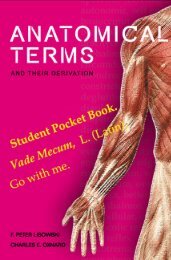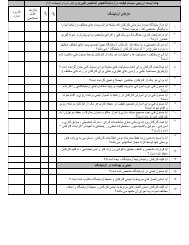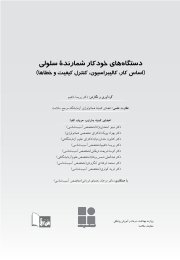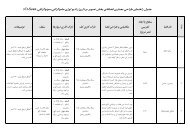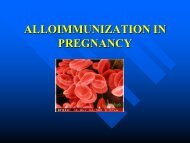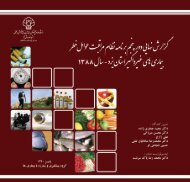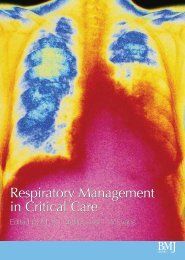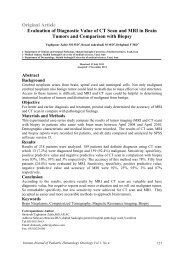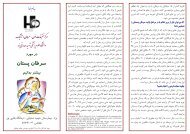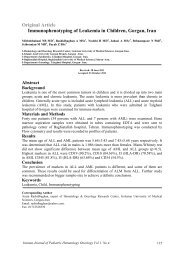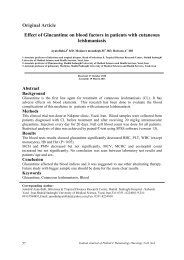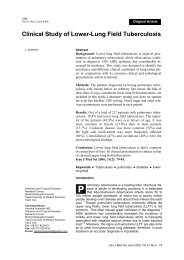Afebrile seizure subsequent to initial febrile seizure
Afebrile seizure subsequent to initial febrile seizure
Afebrile seizure subsequent to initial febrile seizure
You also want an ePaper? Increase the reach of your titles
YUMPU automatically turns print PDFs into web optimized ePapers that Google loves.
O riginal A rticle<br />
Singapore Med J 2012; 53(5) : 1<br />
<strong>A<strong>febrile</strong></strong> <strong>seizure</strong> <strong>subsequent</strong> <strong>to</strong> <strong>initial</strong> <strong>febrile</strong> <strong>seizure</strong><br />
Fallah Razieh 1 , MD, Akhavan Karbasi Sedighah 1 , MD, Golestan Motahhareh 1 , MD<br />
Introduction Febrile <strong>seizure</strong> (FS) is the most common paediatric neurological problem. The purpose of this study was<br />
<strong>to</strong> determine the frequency of a<strong>febrile</strong> <strong>seizure</strong>s <strong>subsequent</strong> <strong>to</strong> FS in children with <strong>initial</strong> FS and <strong>to</strong> evaluate its risk fac<strong>to</strong>rs.<br />
Methods A prospective study was conducted of all children (age range 6 months–6 years) referred with <strong>initial</strong> FS <strong>to</strong><br />
the Shahid Sadoughi Hospital, Yazd, Iran, between August 2004 and March 2006, who were followed up for at least 15<br />
months for the occurrence of <strong>subsequent</strong> a<strong>febrile</strong> <strong>seizure</strong>s.<br />
Results 161 boys and 120 girls (mean age 2.12 ± 1.33 years) were followed up for 34.1 ± 7.8 months. 87 (31%) patients<br />
had complex FS and 19 (6.7%) patients had <strong>subsequent</strong> a<strong>febrile</strong> <strong>seizure</strong>, with a mean occurrence time of 10.6 ± 6.4<br />
months. Univariate analysis via chi-square test showed that <strong>initial</strong> FS within one hour of developing fever (p = 0.0001),<br />
neurodevelopmental delay (p = 0.0001), family his<strong>to</strong>ry of epilepsy (p = 0.0001), recurrent FS (p = 0.003) and focal FS<br />
(p = 0.04) were risk fac<strong>to</strong>rs for <strong>subsequent</strong> a<strong>febrile</strong> <strong>seizure</strong>. On multivariate analysis, neurodevelopmental delay (odds ratio<br />
[OR] 2.6, 95% confidence interval [CI] 2.3–3.4), <strong>initial</strong> FS within one hour of developing fever (OR 1.7, 95% CI 1.2–2.1)<br />
and family his<strong>to</strong>ry of epilepsy (OR 1.5, 95% CI 1.1–1.9) were significant fac<strong>to</strong>rs.<br />
Conclusion In children with FS, special attention should be paid during his<strong>to</strong>ry taking and developmental assessments<br />
<strong>to</strong> identify high-risk patients and those who might need prophylactic anticonvulsants.<br />
Keywords: complex <strong>febrile</strong> <strong>seizure</strong>, epilepsy, <strong>febrile</strong> <strong>seizure</strong><br />
Singapore Med J 2012; 53(5): 1–4<br />
INTRODUCTION<br />
Febrile <strong>seizure</strong> (FS) is the most common type of childhood<br />
<strong>seizure</strong>s. It is also a common cause of paediatric admission and<br />
parental concern. The reported incidence of FS is varied, ranging<br />
from 0.35%–1.5% in China (1) <strong>to</strong> 14% in Guam. (2) FS has been<br />
defined by the International League Against Epilepsy as a <strong>seizure</strong><br />
associated with a <strong>febrile</strong> illness in the absence of central nervous<br />
system (CNS) infections or acute electrolyte abnormalities in a<br />
child older than one month without previous a<strong>febrile</strong> <strong>seizure</strong>s. (3)<br />
According <strong>to</strong> Berg, FS can occur between six months and six years<br />
of age. (4) It may also occur in children with normal and abnormal<br />
neurological development. FSs are further classified as simple or<br />
complex, with the <strong>seizure</strong> being defined as complex FS if <strong>seizure</strong><br />
duration is more than 15 minutes, repeated <strong>seizure</strong>s occur within<br />
24 hours and focal <strong>seizure</strong> activity or focal findings are present<br />
during the postictal period. (5)<br />
One major concern when dealing with children with <strong>initial</strong><br />
FS is the risk of <strong>subsequent</strong> epilepsy; 10%–15% of epileptic<br />
patients have a his<strong>to</strong>ry of FS, which is several times higher than<br />
that in the general population (range 2%–4%). (6) The risk fac<strong>to</strong>rs<br />
for <strong>subsequent</strong> epilepsy after <strong>initial</strong> FS, based on different studies,<br />
are: (1) neurodevelopmental delay and abnormal neurological<br />
exam (1,7-11) ; (2) complex features (7,9-13) – focal (10,11,13,14) or prolonged (8,14) ;<br />
(3) family his<strong>to</strong>ry of epilepsy (1,7,8,10,15,16) ; (4) FS in less than one year of<br />
age (1,8,15) ; (5) recurrent FS (10,11) ; (6) FS within an hour of recognised<br />
onset of fever (9,17) ; (7) <strong>seizure</strong> in temperatures less than 39°C (18) ;<br />
(8) late onset of FS (over three years of age) (15) ; (9) abnormal<br />
electroencephalography (EEG) (8,16) ; and (10) low Apgar scores at<br />
five minutes. (15)<br />
Various studies have found various risk fac<strong>to</strong>rs for epilepsy after<br />
FS, with some of the most controversial discussions in epilepsy<br />
being associated with mesial temporal sclerosis (MTS) due <strong>to</strong><br />
prolonged FS and the development of complex partial <strong>seizure</strong>s<br />
or temporal lobe epilepsy. Some studies have shown that<br />
hippocampal injury evolving <strong>to</strong> hippocampal atrophy is found<br />
in children with focal and prolonged complex FS, but not in<br />
those with generalised <strong>febrile</strong> convulsions. (19-21) However, the<br />
interpretation of such observations remains a controversy, as such<br />
observations suggest acute injury <strong>to</strong> the hippocampus during<br />
FS even while the possibility of pre-existing lesions leading <strong>to</strong><br />
susceptibility <strong>to</strong> injury is not excluded. (20) Indeed, epidemiological<br />
studies indicate that FS is not associated with major cases of MTS<br />
just as clinicopathological studies have revealed multiple potential<br />
causes of MTS and that subtle migration defects may have a role <strong>to</strong><br />
play. (6) Such association may represent an inherent susceptibility in<br />
some children who are predisposed <strong>to</strong> prolonged FS and epilepsy<br />
simultaneously. Evidence now indicates that a genetic background<br />
is an important causal fac<strong>to</strong>r for FS and MTS, and that interactions<br />
between genetic and environmental fac<strong>to</strong>rs may contribute <strong>to</strong> the<br />
association between FS and temporal lobe epilepsy. (20) The overall<br />
risk of MTS associated with complex FS is about 3%. (22) According<br />
<strong>to</strong> one study, baseline neurological disease and personal or family<br />
his<strong>to</strong>ry of epilepsy were higher in children with <strong>febrile</strong> status<br />
epilepticus (<strong>seizure</strong> > 30 minutes) than in those with briefer FS. (23)<br />
1 Department of Paediatrics, Shahid-Sadoughi University of Medical Sciences, Yazd, Iran<br />
Correspondence: Akhavan Karbasi Sedighah, Associate Professor, Department of Paediatrics, Shahid Sadoughi Hospital, Ave Sina St, Shahid Ghandi Blvd, Yazd, IR,<br />
Iran. sakarbasi@ssu.ac.ir
O riginal A rticle<br />
The present study aimed <strong>to</strong> determine the frequency of<br />
a<strong>febrile</strong> <strong>seizure</strong> <strong>subsequent</strong> <strong>to</strong> <strong>initial</strong> FS in children in Yazd, Iran,<br />
and evaluate associated risk fac<strong>to</strong>rs.<br />
METHODS<br />
A prospective study was conducted of all children (age<br />
range 6 months–6 years) referred with <strong>initial</strong> FS <strong>to</strong> the Shahid<br />
Sadoughi Hospital, Yazd, Iran, a tertiary hospital, between<br />
August 2004 and March 2006, who were followed up for at least<br />
15 months for the occurrence of <strong>subsequent</strong> a<strong>febrile</strong> <strong>seizure</strong>s.<br />
The Berg definition of FS (age range 6 months–6 years) was<br />
followed. (4,24) The study was approved by the ethics committee of<br />
the hospital.<br />
At the Department of Pediatrics, Shahid Sadoughi University<br />
of Medical Sciences, Yazd, Iran, children with <strong>initial</strong> FS are<br />
usually admitted <strong>to</strong> the emergency department and observed<br />
for at least 12 hours prior <strong>to</strong> being discharged or admitted <strong>to</strong> the<br />
paediatric ward based on the patient’s condition. Children with<br />
FS (aged less than one year), complex FS, evidence of increased<br />
intracranial pressure, severe infection (e.g. pneumonia, urinary tract<br />
infection, etc.), suspected CNS infections and unreliable parents<br />
were admitted <strong>to</strong> the ward. Children with a his<strong>to</strong>ry of a<strong>febrile</strong><br />
<strong>seizure</strong>s, evidence of CNS infection, shigellosis encephalopathy,<br />
electrolyte abnormalities and those that could not be followed<br />
up were excluded from the study. The highest rectal temperature<br />
recorded during hospital stay was defined as the maximum<br />
temperature.<br />
Variables such gender, age, developmental status, duration<br />
of fever, maximum temperature, type of FS (simple or complex<br />
based on medical records), presence of family his<strong>to</strong>ry of FS/<br />
a<strong>febrile</strong> <strong>seizure</strong> in first- and second-degree relatives (based on<br />
his<strong>to</strong>ry taking and direct interview of the child’s parents), and type<br />
and duration of <strong>seizure</strong> (generalised or partial) were reviewed.<br />
For improved diagnosis, the patient’s developmental status was<br />
assessed using the Denver II Developmental Screening Test<br />
(DDST) by a paediatrician and paediatric neurologist.<br />
Data were analysed using the Statistical Package for the<br />
Social Sciences version 15 (SPSS Inc, Chicago, IL, USA). The chisquare<br />
test was used <strong>to</strong> compare qualitative variables between<br />
patient groups with and without <strong>subsequent</strong> a<strong>febrile</strong> <strong>seizure</strong>,<br />
and mean values were compared using the independent t-test.<br />
Documented risk fac<strong>to</strong>rs from previous studies were <strong>initial</strong>ly<br />
examined by univariate analysis using chi-square test, after which<br />
multivariate Cox regression analysis was done <strong>to</strong> examine the risk<br />
of occurrence of individual risk fac<strong>to</strong>rs recognised on univariate<br />
analysis. Rate ratios were calculated for individual risk fac<strong>to</strong>rs with<br />
95% confidence intervals (CI). The Kaplan-Meier method was used<br />
<strong>to</strong> calculate the probability of the occurrence of a<strong>febrile</strong> <strong>seizure</strong><br />
during the follow-up period. A p-value < 0.05 was considered <strong>to</strong><br />
be statistically significant.<br />
RESULTS<br />
A <strong>to</strong>tal of 298 children were referred with <strong>initial</strong> FS <strong>to</strong> the<br />
Table I. Risk fac<strong>to</strong>rs for <strong>subsequent</strong> a<strong>febrile</strong> <strong>seizure</strong> identified<br />
on univariate analysis.<br />
Fac<strong>to</strong>r No. of patients p-value<br />
Gender<br />
Male<br />
Female<br />
Age at first <strong>seizure</strong> (yr)<br />
< 1<br />
> 1<br />
Duration of fever prior<br />
<strong>to</strong> <strong>initial</strong> <strong>seizure</strong> (hr)<br />
< 1<br />
> 1<br />
Maximum temperature<br />
during hospital stay<br />
38.5°C–40°C<br />
> 40°C<br />
Developmental delay<br />
Yes<br />
No<br />
FS type<br />
Simple<br />
Complex<br />
Recurrent FS<br />
Yes<br />
No<br />
Seizure type<br />
Generalised<br />
Focal<br />
Seizure duration > 10 min<br />
Yes<br />
No<br />
Family his<strong>to</strong>ry of FS<br />
Yes<br />
No<br />
Family his<strong>to</strong>ry of epilepsy<br />
Yes<br />
No<br />
Department of Pediatrics during the period of study. However, 17<br />
patients were lost <strong>to</strong> follow-up and therefore excluded. 161 boys<br />
and 120 girls (mean age 2.12 ± 1.33 years) met the criterion of<br />
follow-up for at least 15 months. The mean duration of followup<br />
was 34.1 ± 7.8 (range 15–48) months. 194 (69%) patients<br />
presented with simple FS and 87 (31%) children had complex FS.<br />
Among those with complex FS, 44 children had multiple <strong>seizure</strong>s<br />
within 24 hours, 16 had focal features and 27 had prolonged<br />
convulsion.<br />
The age-wise distribution of children with <strong>initial</strong> FS indicated<br />
that a majority were between 1–2 years of age: < 1 year (n = 61),<br />
1–2 years (n = 124), 2–4 years (n = 81) and > 4 years (n = 15).<br />
The most common aetiologies of fever were upper respira<strong>to</strong>ry<br />
tract infection (n = 93, 33%), gastroenteritis (n = 57, 20.3%), otitis<br />
media (n = 53, 18.9%) and unknown (n = 45, 16%). 14 patients<br />
had neurodevelopmental delay, the aetiologies for which were<br />
structural CNS dysgenesis (n = 6), asphyxia (n = 5), neonatal<br />
intracranial haemorrhage (n = 2) and neonatal sepsis (n = 1). 19<br />
Yes<br />
12<br />
7<br />
4<br />
15<br />
9<br />
10<br />
15<br />
4<br />
9<br />
10<br />
11<br />
8<br />
13<br />
6<br />
16<br />
3<br />
4<br />
15<br />
10<br />
9<br />
14<br />
5<br />
No<br />
149<br />
113<br />
57<br />
205<br />
31<br />
231<br />
251<br />
11<br />
6<br />
255<br />
183<br />
79<br />
91<br />
171<br />
249<br />
13<br />
23<br />
239<br />
49<br />
213<br />
31<br />
231<br />
0.34<br />
0.94<br />
0.0001<br />
0.62<br />
0.0001<br />
0.28<br />
0.003<br />
0.04<br />
0.32<br />
0.07<br />
0.0001<br />
Singapore Med J 2012; 53(5) : 2
O riginal A rticle<br />
(6.7%) patients had <strong>subsequent</strong> a<strong>febrile</strong> <strong>seizure</strong> (<strong>to</strong>nic-clonic<br />
generalised <strong>seizure</strong>, n = 12; <strong>to</strong>nic <strong>seizure</strong>, n = 4; clonic <strong>seizure</strong>,<br />
n = 2; a<strong>to</strong>nic <strong>seizure</strong>, n = 1), with a mean occurrence time of<br />
10.6 ± 6.4 months. The cumulative percentage of a<strong>febrile</strong> <strong>seizure</strong><br />
occurrence, according <strong>to</strong> the Kaplan-Meier method, was 31%<br />
at one month, 78% at six months, 87% at one year and 92% at<br />
18 months. During follow-up, the occurrence rate did not show<br />
any further increase at two years after the first episode. Three<br />
children had status epilepticus, but none of them had <strong>subsequent</strong><br />
a<strong>febrile</strong> <strong>seizure</strong>. Partial <strong>seizure</strong> was not seen in any patient. Five<br />
patients had a his<strong>to</strong>ry of birth asphyxia and one child had closed<br />
lip schizencephaly. The aetiology of <strong>subsequent</strong> a<strong>febrile</strong> <strong>seizure</strong><br />
was not found for 13 children.<br />
Univariate analysis of risk fac<strong>to</strong>rs (Table I) indicated that<br />
<strong>initial</strong> FS within one hour of developing fever (p = 0.0001),<br />
neurodevelopmental delay (p = 0.0001), positive family his<strong>to</strong>ry<br />
of epilepsy in first- and second-degree relatives (p = 0.0001),<br />
recurrent FS (p = 0.003) and focal FS (p = 0.04) were risk fac<strong>to</strong>rs<br />
for a<strong>febrile</strong> <strong>seizure</strong>s <strong>subsequent</strong> <strong>to</strong> <strong>initial</strong> FS. Multivariate analysis<br />
revealed statistical significance for only three of the above<br />
fac<strong>to</strong>rs – neurodevelopmental delay, family his<strong>to</strong>ry and <strong>seizure</strong><br />
within one hour of developing fever. Multivariate Cox regression<br />
analysis revealed the risk of occurrence of these fac<strong>to</strong>rs as:<br />
neurodevelopmental delay (odds risk [OR] 2.6, 95% CI 2.0–3.4;<br />
p = 0.0001), <strong>initial</strong> FS within one hour of developing fever (OR 1.7,<br />
95% CI 1.2–2.1; p = 0.02) and positive family his<strong>to</strong>ry of epilepsy<br />
(OR 1.5, 95% CI 1.1–1.9; p = 0.03).<br />
DISCUSSION<br />
A majority of patients in this study were boys (57%), and the<br />
occurrence of <strong>initial</strong> FS was also more common in boys, similar<br />
<strong>to</strong> other reports, (1,15) although the frequency of <strong>subsequent</strong> a<strong>febrile</strong><br />
<strong>seizure</strong> was not statistically different between the genders.<br />
Complex FS was seen in 31% of patients in this study, although<br />
other studies have reported a range of prevalence (6.7%–35%).<br />
(2,4,19)<br />
This difference in findings may be due <strong>to</strong> a variety of reasons,<br />
including ethnic and geographic differences, better diagnosis<br />
of partial <strong>seizure</strong>s and improved methods of patient selection.<br />
Subsequent a<strong>febrile</strong> <strong>seizure</strong>s were seen among 6.7% of patients<br />
in the present study, which was similar <strong>to</strong> some reports (7,15) but not<br />
<strong>to</strong> others (range 0.9%–12%). (1,2,9-11) The disparity in findings may be<br />
attributable <strong>to</strong> various fac<strong>to</strong>rs such as the age of children enrolled,<br />
type of FS, period of follow-up and sample size in addition <strong>to</strong> ethnic<br />
and geographic differences and methods of patient selection.<br />
Studies have established the direct relationship between<br />
the number of risk fac<strong>to</strong>rs and the rate of <strong>subsequent</strong> a<strong>febrile</strong><br />
<strong>seizure</strong>. (7,9) Fetveit found that the most important risk fac<strong>to</strong>rs for<br />
<strong>subsequent</strong> a<strong>febrile</strong> <strong>seizure</strong>s were the presence of developmental<br />
or neurological abnormality, family his<strong>to</strong>ry of epilepsy and<br />
complex FS. (7) Sadleir and Scheffer found that prolonged FS was<br />
associated with an increased incidence of epilepsy (21%), with<br />
the risk increasing <strong>to</strong> 49% for children with all three features of<br />
complex FS. (9)<br />
We found that <strong>seizure</strong> within an hour of the recognised onset<br />
of fever was a risk fac<strong>to</strong>r for <strong>subsequent</strong> a<strong>febrile</strong> <strong>seizure</strong>s, similar<br />
<strong>to</strong> earlier studies, (9,17) as was family his<strong>to</strong>ry of epilepsy, which is<br />
also in agreement with other reports. (1,7,8,10,11,15,16) These findings<br />
support the suggestion that the association between FS and<br />
epilepsy may demonstrate a genetic link between FS and epilepsy<br />
rather than a cause and effect relationship. (7) Neurodevelopmental<br />
delay was also a significant risk fac<strong>to</strong>r for <strong>subsequent</strong> a<strong>febrile</strong><br />
<strong>seizure</strong>, similar <strong>to</strong> other reports. (1,7-11) In view of these findings,<br />
the general recommendation of EEG for a child with FS and<br />
neurodevelopmental delay or neurological deficits seems <strong>to</strong> be<br />
well supported. (1,6,25) It should be noted that a majority of children<br />
will have minor electroencephalographic abnormalities (7,8) if<br />
the EEG is done within the first month after FS and that definite<br />
paroxysmal epileptic discharges (spikes, spike and wave, and<br />
poly spike and wave discharges) in EEG are highly suggestive of<br />
<strong>subsequent</strong> epilepsy in a child. (8)<br />
The determination of risk fac<strong>to</strong>rs for <strong>subsequent</strong> a<strong>febrile</strong><br />
<strong>seizure</strong> following <strong>initial</strong> FS in children is not only important for<br />
the timely recognition of susceptible children but also has clinical<br />
implications as such children may need special attention. (11,15)<br />
Various studies have reported various risk fac<strong>to</strong>rs for epilepsy after<br />
<strong>initial</strong> FS. We found that <strong>subsequent</strong> a<strong>febrile</strong> <strong>seizure</strong>s did not occur<br />
in a majority of children with FS. However, neurodevelopmental<br />
delay (odds ratio [OR] 2.6, 95% CI 2.3–3.4), <strong>initial</strong> FS within one<br />
hour of developing fever (OR 1.7, 95% CI 1.2–2.1) and family<br />
his<strong>to</strong>ry of epilepsy (OR 1.5, 95% CI 1.1–1.9) were risk fac<strong>to</strong>rs for<br />
<strong>subsequent</strong> a<strong>febrile</strong> <strong>seizure</strong> in children. In children with FS, special<br />
attention should be paid during his<strong>to</strong>ry taking and developmental<br />
assessments <strong>to</strong> identify high-risk patients and those who might<br />
need prophylactic anticonvulsants. Studies with longer follow-up<br />
periods and larger sample sizes are needed <strong>to</strong> further corroborate<br />
the results of this study.<br />
ACKNOWLEDGEMENTS<br />
This study was funded by a grant from the Deputy for Research<br />
at Shahid Sadoughi University of Medical Sciences, Yazd, Iran.<br />
REFERENCES<br />
1. Leung AK, Robson WL. Febrile <strong>seizure</strong>s. J Pediatr Health Care 2007;<br />
2:250-5.<br />
2. Waruiru C, Apple<strong>to</strong>n R. Febrile convultions: an update. Arch Dis Child<br />
2004; 89:751-6.<br />
3. Jones T, Jacobsen SJ. Childhood <strong>febrile</strong> <strong>seizure</strong>s: overview and implications.<br />
Int J Med Sci 2007; 4:110-4.<br />
4. Berg AT. Are <strong>febrile</strong> <strong>seizure</strong>s provoked by a rapid rise in temperature Am<br />
J Dis Child 1993; 147:1101-3.<br />
5. Johnson MV. Febrile Seizure. In: Behrman RE, Kliegman RM, Jenson HB,<br />
Stan<strong>to</strong>n BF, eds. Nelson Textbook of Pediatrics, 18th ed. Philadelphia:<br />
Saunders; 2007: 2457-80.<br />
6. Shinnar S. Febrile Seizures. In: Swaiman KF, Ashwal S, Ferriero DM, eds.<br />
Pediatric Neurology: Principles and Practice, 4th ed. Philadelphia: Mosby<br />
Elsevier; 2007: 1079-89.<br />
7. Fetveit A. Assessment of <strong>febrile</strong> <strong>seizure</strong>s in children. Eur J Pediatr 2008;<br />
167:17-27.<br />
8. Varma RR. Febrile <strong>seizure</strong>s. Indian J Pediatr 2002; 69:697-700.<br />
9. Sadleir LG, Scheffer IE. Febrile <strong>seizure</strong>s. BMJ 2007; 334:307-11.<br />
Singapore Med J 2012; 53(5) : 3
O riginal A rticle<br />
10. Nelson KB, Ellenberg JH. Predic<strong>to</strong>rs of epilepsy in children who have<br />
experienced <strong>febrile</strong> <strong>seizure</strong>s. N Engl J Med 1976; 295:1029-33.<br />
11. Tsai ML, Hung KL. Risk fac<strong>to</strong>rs for <strong>subsequent</strong> epilepsy after <strong>febrile</strong><br />
<strong>seizure</strong>s. J Formos Med Assoc 1995; 94:327-31.<br />
12. Durá-Travé T, Yoldi-Petri ME. [A long-term follow-up of 234 children with<br />
<strong>febrile</strong> <strong>seizure</strong>s]. Rev Neurol 2004; 39:1104-8. Spanish.<br />
13. Sapir D, Leitner Y, Harel S, Kramer U. Unprovoked <strong>seizure</strong>s after complex<br />
<strong>febrile</strong> <strong>seizure</strong>s. Brain Dev 2000; 22:484-6.<br />
14. Annegers JF, Hauser WA, Shirts SB, Kurland LT. Fac<strong>to</strong>rs prognostic of<br />
unprovoked <strong>seizure</strong>s after <strong>febrile</strong> <strong>seizure</strong>s. N Engl J Med 1987; 316:493-8.<br />
15. Vestergaard M, Pedersen CB, Sidenius P, Olsen J, Christensen J. The longterm<br />
risk of epilepsy after <strong>febrile</strong> <strong>seizure</strong>s in susceptible subgroups. Am J<br />
Epidemiol 2007; 165:911-8.<br />
16. Birca A, Guy N, Fortier I, et al. Genetic influence on the clinical characteristics<br />
and outcome of <strong>febrile</strong> <strong>seizure</strong>s--a retrospective study. Eur J Paediatr Neurol<br />
2005; 9:339-45.<br />
17. Berg AT, Shinnar S. Unprovoked <strong>seizure</strong>s in children with <strong>febrile</strong> <strong>seizure</strong>s:<br />
short term outcome. Neurology 1996; 47:562-8.<br />
18. El-Radhi AS. Lower degree of fever at the <strong>initial</strong> <strong>febrile</strong> convulsion is<br />
associated with increased risk of <strong>subsequent</strong> <strong>seizure</strong>s. Eur J Paediatr Neurol<br />
1998; 2:91-6.<br />
19. Barr WB, Ashtari M, Schaul N. Bilateral reductions in hippocampal volume<br />
in adults with epilepsy and a his<strong>to</strong>ry of <strong>febrile</strong> <strong>seizure</strong>s. J Neurol Neurosurg<br />
Psychiatry 1997; 63:461-7.<br />
20. Cendes F. Febrile <strong>seizure</strong>s and mesial temporal sclerosis. Curr Opin Neurol<br />
2004; 17:161-4.<br />
21. Scott RC, King MD, Gadian DG, Neville BG, Connelly A. Prolonged<br />
<strong>febrile</strong> <strong>seizure</strong>s are associated with hippocampal vasogenic edema and<br />
developmental changes. Epilepsia 2006; 47:1493-8.<br />
22. Chungath M, Shorvon S. The mortality and morbidity of <strong>febrile</strong> <strong>seizure</strong>s.<br />
Nat Clin Pract Neurol 2008; 4:610-21.<br />
23. Shinnar S, Pellock JM, Berg AT, et al. Short-term outcomes of children with<br />
<strong>febrile</strong> status epilepticus. Epilepsia 2001; 42:47-53.<br />
24. Lewis D. Paroxysmal Disorders. In: Kliegman RM, Marcdnate KJ, Jenson<br />
HB, Behrman RE, eds. Nelson Essential of Pediatrics, 5th ed. Philadelphia:<br />
Saunders; 2006: 833-40.<br />
25. Cuestas E. Is routine EEG helpful in the management of complex <strong>febrile</strong><br />
<strong>seizure</strong>s Arch Dis Child 2004; 89:290.<br />
Singapore Med J 2012; 53(5) : 4



